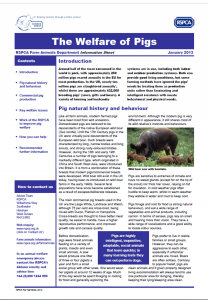Pig Welfare Assessment
“To ensure we are improving farm animal welfare we need to be able to measure it. Measuring welfare enables us to know what level is being achieved on-farm and therefore better understand what impact the resources being provided and management practices being implemented are having on the animal” www.assurewel.org.
Visit our Animal Welfare Assessment page in Veterinary Questions to find out more about welfare assessment and visit the AssureWel website for practical information on assessing the welfare of pigs.
The Real Welfare project involves on-farm assessment of pig welfare using a set of five objective and repeatable measures. These measures are known as ‘welfare outcomes’ which are animal-based, meaning that they are obtained from the animals themselves, rather than from their environment. These measures include numbers of pigs that would benefit from removal to hospital pen, lame pigs, pigs with tail lesions, pigs with body lesions and the amount of enrichment provision.


 American English
American English


Comments are closed.